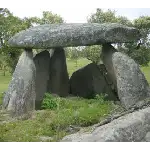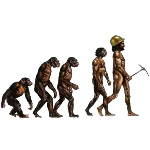Curiosities and Challenges about Prehistory
Do you like Prehistory?
Would you like to see more curiosities like these..
There are several ways to unravel the mysteries of the past. Historians, who are specialists who study and document the....
Archeology plays an important role in understanding the past by studying material remains left by ancient human..
The evolution of the human species began in East Africa approximately 4.2 million years ago with Australopithecus....
So.. How about a Challenge on the Best Quiz Platform in the World?
Every scene is an opportunity to shine
Get to know a little about everything and bet on your knowledge in incredible challenges and duels..
Join the betspot.zone community, accumulate bts (bets) and even compete for prizes..
Discover some interesting facts about Prehistory..
pre Quiz - pre Curiosities - pre Challenge - academic Quiz - academic Curiosities - academic Challenge - history Quiz - history Curiosities -history Challenge - school Quiz - school Curiosities - school Challenge - - Frequently asked questions about Prehistory
Some specific characteristics of some species of hominins: A

Some specific characteristics of some species of hominins: Australopithecus (it lived in Africa, the first primate similar to Man and moved mainly on two legs (bipedal), although sometimes it used its hands); Homo habilis (he moved only on his feet and was the first to make instruments: carved pebbles, made of stone, carved on only one side); Homo ergaster/erectus (arrived in Asia and Europe, manufactured more perfected instruments: bifaces (allowed to hunt, prepare game pieces, defend against enemies, etc…), first to produce fire and developed an articulated language); Homo sapiens (manufactured better instruments in stone, bone, horn and ivory: spearhead, bows, arrows, harpoons, hooks, needles and blades and first to bury the dead) and Homo sapiens sapiens (first to develop artistic manifestations and arrived at America and Oceania).
publicity
During the Neolithic

During the Neolithic, ancient communities adopted religious practices, including star worship and funerary rites. They built megalithic monuments, such as dolmens (stone tombs covered by earth, called mounds), menhirs (isolated vertical stones, which had associations with fertility, nature worship and stars such as the Sun and the Moon) and cromlechs (stone circles). , which had religious and ceremonial purposes. These monuments appeared in Europe around 7000 BC.
Neolithic farmers worshiped nature

Neolithic farmers worshiped nature, fearing natural events like droughts and storms that threatened their crops and livestock. They worshiped the sun, wind, earth, water and moon in hopes of protecting their resources and ensuring bountiful harvests. The emphasis was on the fertility of the land, symbolized by exaggerated female figurines, associated with agrarian cults and community survival.
The transition to agriculture and pastoralism in the Neolith

The transition to agriculture and pastoralism in the Neolithic period resulted in the development of new tools and techniques, such as polished stone tools and milling and weaving techniques. This led to a significant change in lifestyles, with communities moving from nomadic in the Paleolithic to sedentary in the Neolithic. Sedentarization has led to the construction of villages close to vital resources such as water and fertile land. Today, some societies still depend on hunting, fishing and gathering natural foods.
publicity
Between 10,000 and 8,000 BC

Between 10,000 and 8,000 BC, climate changes led to the growth of grassy plants, such as wheat and barley, near rivers. Humans realized that they could grow these plants and started to practice agriculture. At the same time, they built fences for animals and began to domesticate dogs, sheep and goats. This led to a productive lifestyle, producing food and other goods. The practice of agriculture made people settle in fertile areas, leading to sedentarization. These landmark changes in human life are known as the Neolithic Revolution and began in the Fertile Crescent regions. This period in Prehistory is called the Neolithic, characterized by agriculture, animal domestication, sedentarization and the use of more advanced polished stone tools.
Paleolithic art can be divided into two distinct types: Rock

Paleolithic art can be divided into two distinct types: Rock Art, which was performed on the surface of rocks, in outdoor locations or on the walls and ceilings of caves. It usually depicted hunting scenes, animals, and occasionally human hands and figures. Some of the main centers of rock art are in the Franco-Cantabrian region, such as Lascaux and Altamira, in addition to the Spanish Levante and the Côa Valley, in Portugal. On the other hand, Mobile Art included small sculptures, such as the famous female figures Venus, as well as objects of adornment, such as bracelets, rings, and bas-reliefs made in stone, bone or ivory, which were easily transportable.
In the Paleolithic

In the Paleolithic, our ancestors practiced magical rituals to influence natural events such as death and storms, due to their dependence on natural conditions to survive. They valued the afterlife and performed funerary rituals, burying the dead in caves or graves in the fetal position, surrounded by stones and accompanied by personal objects, weapons and food. Paleolithic art, represented by paintings of wounded animals in caves, had a magical meaning to facilitate hunting. In addition, exaggerated female figurines called Venus highlighted the importance of motherhood and fertility.
publicity
Early humans depended on nature to survive, hunting

Early humans depended on nature to survive, hunting, fishing and gathering food such as roots, seeds, fruits and eggs. This characterized a collecting lifestyle. When resources were scarce in an area, communities moved in search of food, practicing nomadism. This period, in which chipped stone tools were manufactured and gathering and nomadism prevailed, is called the Paleolithic by archaeologists.
Homo erectus, by observing fire in nature

Homo erectus, by observing fire in nature, learned to produce it, either by rubbing wood or hitting stones. This represented a mastery of nature, allowing early communities to keep warm, develop language, cook food, and more. These physical and linguistic changes facilitated cooperation and planning in groups. This period, which goes from the first hominids to the discovery of writing, is called Prehistory, a time documented by material remains, such as tools, bones and artifacts, due to the lack of written documents.
The evolution of the human species began in East Africa appr

The evolution of the human species began in East Africa approximately 4.2 million years ago with Australopithecus anamensis. This process, known as hominization, spanned millennia and led to the emergence of Homo sapiens, Modern Man. During this journey, there were advancements in toolmaking, firebending, and skill acquisition. Homo habilis began creating simple stone tools, evolving into hand axes under Homo erectus. Homo sapiens sapiens refined tool-making, using materials such as ivory, bone, and wood to create advanced tools. These tools played crucial roles in hunting, treating fur, and making clothing, as well as being useful for fishing and hunting large game.
publicity
Archeology plays an important role in understanding the past

Archeology plays an important role in understanding the past by studying material remains left by ancient human communities. These traces, which range from small bones to pottery fragments, are discovered through archaeological excavations and often displayed in museums. In addition, historians divide time into periods, called historical periodization, to mark different phases in the evolution of humanity, such as the transition from Prehistory to History, which was marked by the invention of writing.
There are several ways to unravel the mysteries of the past

There are several ways to unravel the mysteries of the past. Historians, who are specialists who study and document the past, use a wide variety of traces left by ancient human societies, such as texts, photographs, paintings, buildings, sculptures, objects, clothing, oral reports, films, music and even fragments. of bones. They examine these sources to investigate information, formulate hypotheses and draw conclusions about events and aspects of the past. The set of traces left by ancient human societies, together with texts written by historians, encyclopedias and reconstructions of historical environments, is called historical sources. These sources are vital to understanding and interpreting past events.
Back
